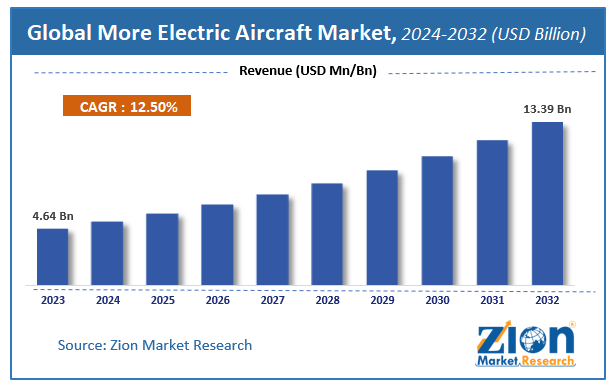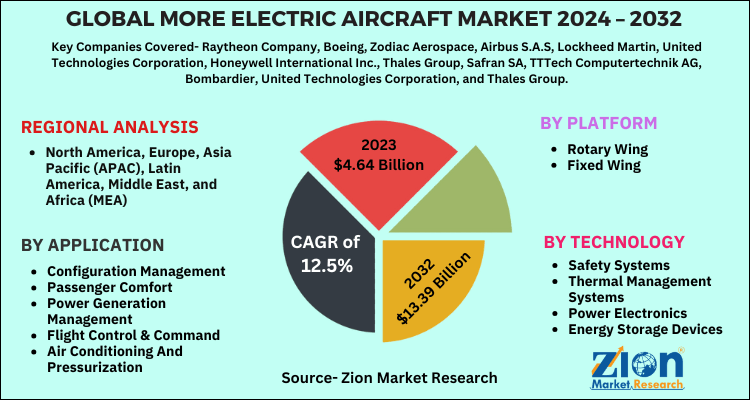More Electric Aircraft Market Size, Share, Analysis, Trends, Growth Report, 2032

More Electric Aircraft Market - by Platform (Fixed Wing, Rotary Wing) System (Power Electronics, Energy Storage Equipment, Thermal Management System) Application (Power Distribution, Flight Control & Operations, Passenger Comfort, Air Pressurization & Conditioning): Global Industry Perspective, Comprehensive Analysis and Forecast, 2024 - 2032
| Market Size in 2023 | Market Forecast in 2032 | CAGR (in %) | Base Year |
|---|---|---|---|
| USD 4.64 Billion | USD 13.39 Billion | 12.5% | 2023 |
More Electric Aircraft Market Insights
According to a report from Zion Market Research, the global More Electric Aircraft Market was valued at USD 4.64 Billion in 2023 and is projected to hit USD 13.39 Billion by 2032, with a compound annual growth rate (CAGR) of 12.5% during the forecast period 2024-2032. This report explores market strengths, weakness, opportunities, and threats. It also provides valuable insights into the market's growth drivers, challenges, and the future prospects that may emerge in the More Electric Aircraft industry over the next decade.
More Electric Aircraft Market: Overview
The aviation industry is on the cusp of a major transformation with the rise of More Electric Aircraft (MEA). The demand for cleaner, quieter, and more efficient aircraft has accelerated the shift towards replacing traditional hydraulic and pneumatic systems with electric systems. MEAs represent a pivotal step towards achieving the ultimate goal of fully electric aircraft, offering environmental, economic, and operational benefits.
What is a More Electric Aircraft (MEA)?
More Electric Aircraft refers to airplanes that replace many traditional mechanical, hydraulic, and pneumatic systems with electric-powered alternatives. In MEAs, systems such as flight control, landing gear, and environmental control systems are powered by electricity instead of older mechanical systems. By doing so, these aircraft become more efficient, reducing fuel consumption, maintenance costs, and the overall weight of the aircraft.
The MEA concept is a critical stepping stone to the eventual development of all-electric or hybrid-electric aircraft, which promise even more significant environmental and operational benefits.
The product is the next-gen airplane that is fitted with electrical systems to reduce the non-propulsive power systems including pneumatic, mechanical, and hydraulic systems. In fact, more electric aircraft is a low weight airplane with less fuel usage and reduced emissions. This results in lowered ownership costs and enhances dependability. Due to low mass, the product is the best alternative for the aircraft manufacturers and hence has gained massive popularity across the aviation & aerospace sector.
More Electric Aircraft Market: Growth Factors
Need for reducing operational as well as maintenance costs to a large extent in aircraft will boost the more electric aircraft market trends. Apart from this, a massive requirement for fuel conserving, lightweight and durable airplane coupled with the necessity of minimizing maintenance & operating expenditure will vitalize the growth of the business over the years to come. Additionally, the growing inclination among the mammoth aircraft manufacturers to reduce dependence on traditional aircraft parts as a result of its high prices is touted to further elevate the industry expansion.
Furthermore, strict laws governing GHG emissions along with the need for raising the number of air flights as a result of thriving tourism activities is likely to add significantly towards the industry size during the estimated timeline. Nonetheless, concerns raised over the electric motor stability at heights along with a huge generation of heat may curtail market demand. However, the industry participants are trying to build strong mechanisms and core technologies to overcome these loopholes of the electric systems, thereby further propelling the market progress.
The More Electric Aircraft market has been growing rapidly, driven by several factors:
1. Environmental Concerns and Regulatory Pressure
With increasing pressure on the aviation industry to reduce carbon emissions, governments and regulatory bodies are imposing stricter environmental regulations. Airlines and aircraft manufacturers are seeking ways to reduce their carbon footprint, and electric aircraft systems offer a solution by reducing fuel consumption and emissions.
2. Technological Advancements
Ongoing advancements in electric power systems, battery technology, and power electronics have made MEA more feasible. Innovations in these areas enable aircraft to operate more efficiently, with reduced energy losses and greater reliability.
For example, high-power-density electric motors and energy storage systems are being developed to support the growing energy demands of MEAs.
3. Operational Efficiency
MEA technology allows for lighter and simpler aircraft, leading to reduced fuel consumption and maintenance costs. By replacing complex hydraulic and pneumatic systems with simpler electrical systems, airlines benefit from easier maintenance and reduced downtime, directly impacting operational efficiency and profitability.
4. Rising Fuel Costs
As global fuel prices fluctuate and become less predictable, airlines are increasingly looking for ways to minimize fuel consumption. MEAs, which use less fuel due to their lightweight and efficient design, are seen as a critical solution for reducing operating costs.
5. Demand for Quieter Aircraft
MEA technologies significantly reduce the noise produced by traditional aircraft systems, particularly during takeoff and landing. This is a key advantage for airlines and manufacturers, especially as airports located near densely populated areas face stricter noise regulations.
6. Increased Investment in R&D
The rise of electric propulsion and green aviation is attracting significant investment from both public and private sectors. Companies like Airbus, Boeing, Rolls-Royce, and Safran are investing heavily in the development of MEA technologies, including electric propulsion and more efficient energy storage systems.
Governments and regulatory bodies are also supporting this transition through funding initiatives that encourage the adoption of electric technologies in aviation.
More Electric Aircraft Market: Segmentation
The more electric aircraft market can be sectored into platform, system, and application.
Based on the platform, the industry can be divided into fixed wing and rotary wing.
On the basis of the system, the more electric aircraft market can be segregated into power electronics, energy storage equipment, thermal management system, and safety system & advanced material.
Application wise, the more electric aircraft industry is classified into power distribution, flight control & operations, passenger comfort, and air pressurization & conditioning.
Region wise, the more electric aircraft market can be divided into five main regions: Europe, Asia Pacific, Latin America, North America, and the Middle East and Africa. More electric aircraft market in Europe is projected to witness a humungous surge due to the enforcement of strict laws addressing the need for curbing fuel emissions from aircraft. In addition to this, favorable schemes supporting product adoption are likely to expedite the business space over the next decade.
More Electric Aircraft Market: Report Scope
| Report Attributes | Report Details |
|---|---|
| Report Name | More Electric Aircraft Market |
| Market Size in 2023 | USD 4.64 Billion |
| Market Forecast in 2032 | USD 13.39 Billion |
| Growth Rate | CAGR of 12.5% |
| Number of Pages | 110 |
| Key Companies Covered | Raytheon Company, Boeing, Zodiac Aerospace, Airbus S.A.S, Lockheed Martin, United Technologies Corporation, Honeywell International Inc., Thales Group, Safran SA, TTTech Computertechnik AG, Bombardier, United Technologies Corporation, and Thales Group |
| Segments Covered | By Product Type, By Application Type And By Region |
| Regions Covered | North America, Europe, Asia Pacific (APAC), Latin America, Middle East, and Africa (MEA) |
| Base Year | 2023 |
| Historical Year | 2018 to 2022 |
| Forecast Year | 2024 - 2032 |
| Customization Scope | Avail customized purchase options to meet your exact research needs. Request For Customization |
More Electric Aircraft Market: Regional Insights
North American region is prophesied to make remarkable contributions toward overall more electric aircraft market revenue, subject to large scale presence of aircraft producers in the countries such as the U.S. and Canada. Allocation of more funds for the defense activities in the region will further create demand for more electric fighter aircraft, thereby unveiling new growth facets for the more electric aircraft sector in North America.
More Electric Aircraft Market: Competitive Space
Some of the major participants in more electric aircraft market are
- Raytheon Company
- Boeing
- Zodiac Aerospace
- Airbus S.A.S
- Lockheed Martin
- United Technologies Corporation
- Honeywell International Inc.
- Thales Group
- Safran SA
- TTTech Computertechnik AG
- Bombardier
- United Technologies Corporation
- Thales Group.
- And Others
The ZMR-published market research report segments the global more electric aircraft market as follows:
By Platform:
- Rotary Wing
- Fixed Wing
By Technology:
- Safety Systems
- Thermal Management Systems
- Power Electronics
- Energy Storage Devices
By Application:
- Configuration Management
- Passenger Comfort
- Power Generation Management
- Flight Control & Command
- Air Conditioning And Pressurization
More Electric Aircraft Market: Regional Segment Analysis
-
North America
- The U.S.
- Canada
- Europe
- France
- The UK
- Spain
- Germany
- Italy
- Rest of Europe
- Asia Pacific
- China
- Japan
- India
- South Korea
- Southeast Asia
- Rest of Asia Pacific
- Latin America
- Brazil
- Mexico
- Rest of Latin America
- Middle East & Africa
- GCC
- South Africa
- Rest of Middle East & Africa
Table Of Content
Methodology
FrequentlyAsked Questions
More Electric Aircraft refers to airplanes that replace many traditional mechanical, hydraulic, and pneumatic systems with electric-powered alternatives. In MEAs, systems such as flight control, landing gear, and environmental control systems are powered by electricity instead of older mechanical systems.
Need for reducing operational as well as maintenance costs to a large extent in aircraft will boost the more electric aircraft market trends. Apart from this, a massive requirement for fuel conserving, lightweight and durable airplane coupled with the necessity of minimizing maintenance & operating expenditure will vitalize the growth of the business over the years to come.
According to a study, the global more electric aircraft Industry size was $4.64 Billion in 2023 and is projected to reach $13.39 Billion by the end of 2032.
The global more electric aircraft market is expected to grow at a CAGR of 12.5% during the forecast period.
North America, Europe, Asia Pacific (APAC), Latin America, Middle East, and Africa (MEA)
More electric aircraft market in Europe is projected to witness a humungous surge due to the enforcement of strict laws addressing the need for curbing fuel emissions from aircraft.
Some of the major participants in more electric aircraft market are Raytheon Company, Boeing, Zodiac Aerospace, Airbus S.A.S, Lockheed Martin, United Technologies Corporation, Honeywell International Inc., Thales Group, Safran SA, TTTech Computertechnik AG, Bombardier, United Technologies Corporation, and Thales Group.
Choose License Type
List of Contents
Market InsightsMarket:OverviewWhat is a (MEA)?Market:Growth FactorsMarket:SegmentationReport ScopeMarket:Regional InsightsMarket:Competitive SpaceThe ZMR-published market research report segments the global more electric aircraft market as follows:By Platform:By Technology:By Application:Regional Segment AnalysisNorth AmericaRelatedNews
HappyClients
Zion Market Research
Tel: +1 (302) 444-0166
USA/Canada Toll Free No.+1 (855) 465-4651
3rd Floor,
Mrunal Paradise, Opp Maharaja Hotel,
Pimple Gurav, Pune 411061,
Maharashtra, India
Phone No +91 7768 006 007, +91 7768 006 008
US OFFICE NO +1 (302) 444-0166
US/CAN TOLL FREE +1 (855) 465-4651
Email: sales@zionmarketresearch.com
We have secured system to process your transaction.
Our support available to help you 24 hours a day, five days a week.
Monday - Friday: 9AM - 6PM
Saturday - Sunday: Closed







